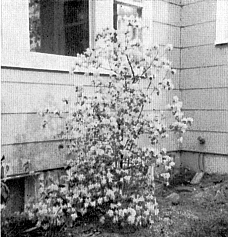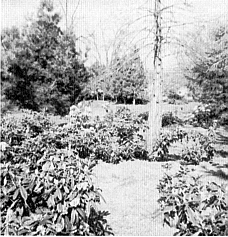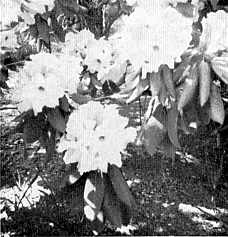QBARS - v25n3 Rhododendrons in South Eastern Washington and Adjacent Areas
Rhododendrons in South Eastern Washington
and Adjacent Areas
By D. Radebaugh Jr., Dayton, Washington
The geographic region covered by this article lies in that part of south eastern Washington south of the Snake and east of the Colombia rivers, north eastern Oregon north of Pendleton and west of the Blue Mountains, and adjacent parts of north central Idaho from Lewiston east along the valleys of the Clearwater River system, all within an elevation range from 350 to approximately 1800 to 2000 feet above sea level, between latitudes 45.30 and 47 degrees. The physiography of the region is one of intermontane plateaus, river valleys and low mountains. The major streams, the Snake, Columbia and Clearwater Rivers are deeply trenched.
In this general region there are many variations of the basic climatic zones as measured by temperature, rain fall, humidity and soil type factors. For the most part this discussion will apply to climate zones 6B and 7A (U. S. Nat'l Arboretum, USDA, Am. Hort. Soc. plant hardiness zone map), and where annual precipitation ranges from 10" to 35" with corresponding humidity conditions.
The specific climate in which the writer has grown rhododendrons is described as having an annual rainfall of 20" with a mean annual temperature of 52°F, average mean temperature January 32.6°F, July 70.8° F. The average frost free growing season is approximately 165 to 170 days. Summers are quite sunny with warm days, low humidity and cool nights. Winter temperatures are generally moderate, but cold periods do occur, caused by polar air masses crossing the Rocky Mountains and invading the region from the north and east. Almost without exception the late fall and winter months are rainy and cloudy or foggy, with a minimum of sunshine. Total snow fall is approximately 12" annually, with the snow remaining on the ground for only a few days. However, in occasional winters snow depths may reach 20 inches, and may remain for as long as three weeks.
The cultural practices for growing rhododendrons successfully in the described region are much the same as those which are followed in inland valleys west of the Cascade Mountains in Oregon and Washington. Each group of species and their hybrids - the alpines, the open woodland and deep forest types - are relatively specific in their requirements for light, soil acidity and texture and moisture. However, in this general area one simply cannot be careless about meeting the plants' requirements for best growth and bloom.
First, as sun light is intense during summer months, partial shade is essential. This can be achieved on the north side of foundation plantings, under or on the edges of deciduous shade trees (except willows, soft maple, cottonwoods and alders), and among pines, firs and other evergreen conifers. An overstory of pines spaced 25 to 50 feet apart, for example, provides almost ideal combinations of sun light and shade for rhododendrons.
Soil acidity ranges in the region from a pH of 7.5 to 5.6, depending on the rain fall and soil type. Ferrous sulphate is used mostly to correct pH to 5.5 to 5.8 according to formulas as prescribed by experiment stations.
When growing rhododendrons in sandy or sandy loam soils, texture is no problem, but where fairly heavy silt clays occur, sand and organic matter - peat or leaf compost - must be incorporated. For those species and hybrids which require exceptional drainage for best growth, a certain amount of gravel is mixed into the sub soil to a depth of 2 feet, or the plants may be grown on raised beds. In the latter instance R. russatum has performed exceptionally well, as have also R. flavidum and R. glaucophyllum .
For maintaining adequate moisture around the root zone of plants during the growing and dormant seasons a mulch consisting approximately of one-half to two-thirds conifer sawdust and one-third oak leaves to a depth of 3 to 5 inches has proven quite satisfactory. Another organic cover perhaps even better for rhododendrons is that of pine needles, especially from Pinus ponderosa, jeffreyi , and monticola . Experience has shown that mulch cover can be maintained as noted above by a new application usually every other year in late November. As soon as the mulch is put down, a dressing of ferrous sulphate to maintain proper pH is applied to the surface. This material is rather quickly taken into the decayed humus zone below the freshly applied materials by fall rains. In addition to the iron, one to two tablespoons of magnesium sulphate is applied around each plant annually. The use of magnesium in growing almost all ericaceous plants in this region is very beneficial.
Plant nutrients are usually supplied to young plants in May, using an acid fertilizer of 4-12-10 formulation. With most species and hybrids which have proved successful here, as the plants get older less and less fertilizer is required, and often several years may elapse before a plant needs additional nutrients - usually after a particularly heavy bloom year.
With the organic cover method, normal irrigations of the plants during the summer months can be followed. For example, if lawns are watered at week to 10-day intervals during the hottest part of the summer, rhododendrons can be irrigated similarly and with the same amounts of water.
When plantings are made in exposed sites some wind protection may be necessary. This is easily accomplished by planting in the lee of columnar arborvitae, junipers (western, Rocky Mt., and forms of J. chinensis ), small tree pines such as bristlecone, pinon and Swiss stone pine and upright Taxus species and varieties.
For approximately twenty years a small number of rhododendron hybrids and species have been grown and tested by the writer. The program has not been large due to lack of space and the interest in other woody plant genera. Hybrids and species which have been grown successfully in this area are shown in the following lists:
| Rhododendron Hybrids | Rhododendron Species | |
| Blue Peter | russatum | |
| Princess Elizabeth | impeditum | |
| Mars | flavidum | |
| Sappho | keiskei | |
| Vulcan | insigne | |
| Purple Splendor | catawbiense | |
| Doncaster | maximum | |
| Mdme. de Bruin | minus | |
| Britannia | carolinianum | |
| America | racemosum (Gable form) | |
| Pygmalion | makinoi | |
| Gomer Waterer | glaucophyllum | |
| P. J. M. hybrid | japonicum | |
| Ostfriesland | nudiflorum | |
| Windbeam | calendulaceum | |
| Conemaugh | schlippenbachii | |
| Boule de Neige | vaseyi | |
| Mdme. Masson | viscosum | |
| R. myrtifolium | roseum | |
| R. arbutifolium | canadense | |
| R. Fraseri | molle | |
| luteum |
In addition to the above, many varieties of the Exbury and Knaphill hybrid azalea groups, and to a lesser degree, the Gable hybrids can be easily grown in this area. The writer does not have a very large number of these kinds, but has observed them growing in regional towns such as Lewiston, Idaho, and Walla Walla, Washington.
Some of the newer hybrid varieties of rhododendron which are under observation, but only in small plant sizes, are Shamarello varieties 'Cheer', 'Tony', 'Lavender Queen', 'King Tut', 'Prize', 'Spring Dawn', 'Pink Flair', and others such as Hobbie's 'Scarlet Wonder', 'Elizabeth Hobbie', and also 'Caroline', 'Scintillation', and 'Unique'. There is every reason to believe that most all of Shammerello's material will be quite hardy, as well as any of the David Leach introductions, for growing in south eastern Washington and the adjacent areas.
The following hybrids and species have not been satisfactory for the region: R. 'Radium', R. wardii, forrestii var. repens, williamsianum, davidsonianum, chryseum, albiflorum, sperabile . It is possible that better success could have been had with R. williamsianum , but this species was only tested once.
A small rhododendron project was developed in the city park of Dayton, Washington, in 1962 for the purpose of demonstrating to the public the value of these plants in ornamental landscaping. Mr. Tony Shammarello of Cleveland (South Euclid), Ohio, was kind enough to supply cuttings of some of his improved hardy hybrid material several years previously. This material was rooted and grown into plants of 15" to 20" size. Approximately 400 plants were set out on a half acre site in the center of the park area. Small ponderosa pine trees were set out on this site at the same time, to provide a suitable shade overstory. This project has been fairly successful with many plants 4 to 5 feet in height and perfectly hardy, although subject to losses from vandalism. It has proven of interest to numerous citizens of the town, and more rhododendron plantings are being made each year in home landscaping.
The writer must also acknowledge the value of material received from Joseph Gable of Stewartstown, Penn. At least 20 years ago a few packets of rhododendron seed were obtained from Mr. Gable, and over 100 seedling plants were grown from these. Over the years many plants were lost, and today only five remain, which are apparently hybrids of R. fortunei. These are large shrubs with good foliage, medium size flower trusses (12 to 15 flowers), quite large florets, and ranging in color from white, pink to pink-lavender shades, and most interesting, all are fragrant! The plants are slightly susceptible to sun burn, and this requires shade protection, but all in all they are first class, hardy shrubs. (FIG. 61).

|

|

|
|
FIG. 59. 'Conemaugh' - 12 year
old plant. |
FIG. 60. Rhododendrons growing
in the city park at Dayton, Wash. |
FIG. 61. Gable R.
fortunei
hybrid,
fragrant, with pink flowers. |
In addition, small numbers of plants of R. keiskei, R. makinoi, R. yakushimanum have been received from Frank Doleshy of Seattle, and R. schlippenbachii (Birch form) from Mr. Edward Birch of Short Hills, New Jersey. This material is presently under observation.
The spell which rhododendrons weave around those who plant these shrubs for any period of time has recently led to the growing from seed (the A.R.S. seed exchange program) of approximately sixty species and crosses. A few of these are R. hirsutum, ferrugineum, fortunei, brachycarpum, metternichii, mucronulatum, yakushimanum, discolor, sutchuenense, auriculatum, dauricum var. sempervirens, arborescens, albrechtii, atlanticum, occidentals, quinquefolium, aureum, kiusianum , and macrophyllum (from 4700' near Odell Lake, Oregon).
Many of the new hybrids being introduced each year should be grown and tested to determine their adaptability in the south eastern Washington, Oregon and northern Idaho not included in this discussion. No doubt there are a number of other individuals living in the Pacific Northwest east of the Cascade Mountains who may have comparable or more experience in the growing of rhododendrons. It would be most interesting to learn about their experiences.
From the results of this small testing program it is strongly believed that ornamental horticulture in all of these areas can be greatly enriched from the addition of the wide range of these beautiful, versatile, hardy shrubs to the landscape scene.
